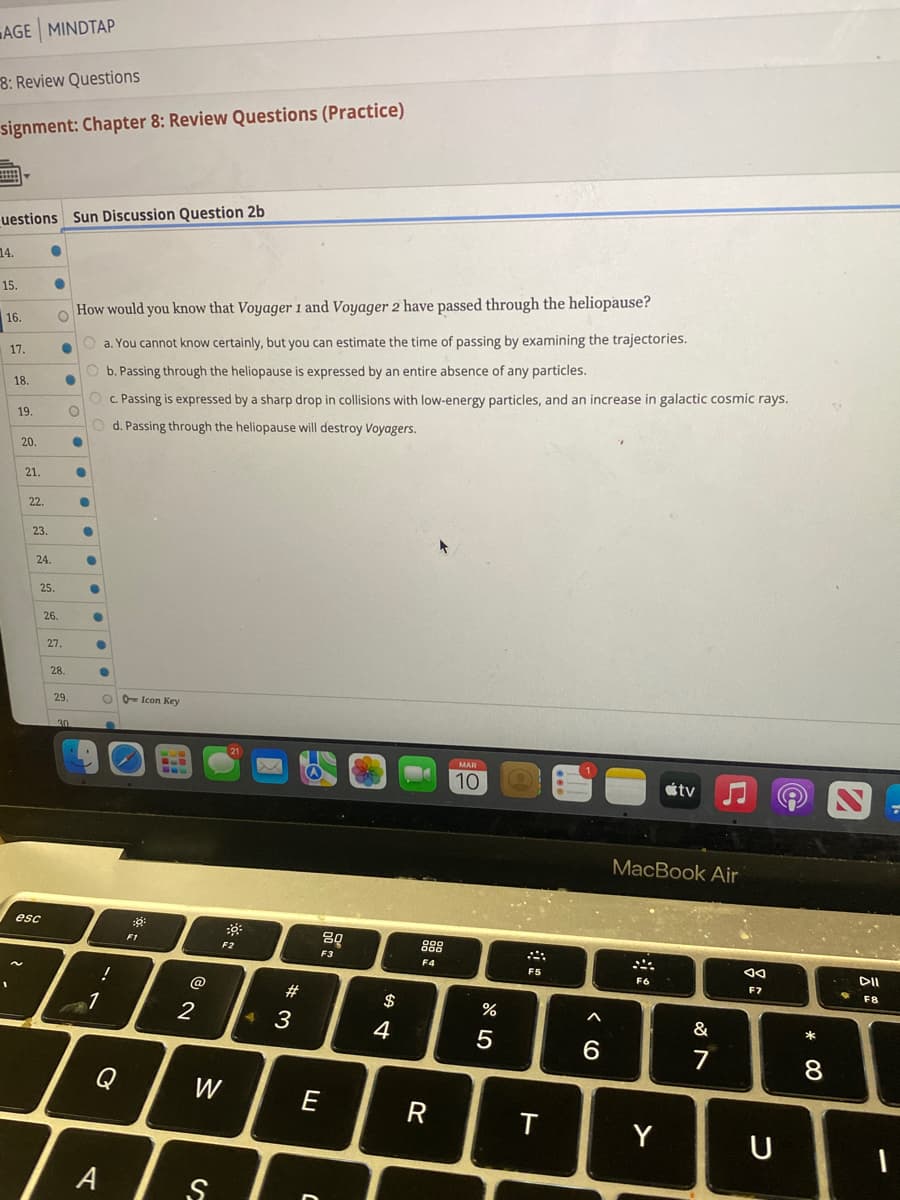What would the spectrum of an auroral display look like? Why? a. It should look like the usual solar spectrum with absorption lines. Earth's upper atmosphere is heated by solar radiation. b. It should look like an emission line spectrum. The light is produced by atoms in Earth's upper atmosphere excited from collisions with particles from the solar wind. c. It should look like spectra of the Sun's chromosphere, with strong emission lines of hydrogen. The light is produced by atoms in Earth's upper atmosphere excited from collisions with particles from the solar wind. Od. It should look like a spectrum of a solar prominence, with strong influence of the magnetic field. Auroral displays are caused by the solar wind.
What would the spectrum of an auroral display look like? Why? a. It should look like the usual solar spectrum with absorption lines. Earth's upper atmosphere is heated by solar radiation. b. It should look like an emission line spectrum. The light is produced by atoms in Earth's upper atmosphere excited from collisions with particles from the solar wind. c. It should look like spectra of the Sun's chromosphere, with strong emission lines of hydrogen. The light is produced by atoms in Earth's upper atmosphere excited from collisions with particles from the solar wind. Od. It should look like a spectrum of a solar prominence, with strong influence of the magnetic field. Auroral displays are caused by the solar wind.
Applications and Investigations in Earth Science (9th Edition)
9th Edition
ISBN:9780134746241
Author:Edward J. Tarbuck, Frederick K. Lutgens, Dennis G. Tasa
Publisher:Edward J. Tarbuck, Frederick K. Lutgens, Dennis G. Tasa
Chapter1: The Study Of Minerals
Section: Chapter Questions
Problem 1LR
Related questions
Question

Transcribed Image Text:Questions
nt: Chapter 8: Review Questions (Practice)
Is Sun Discussion Question 7
●
.
●
A.
25.
26.
What would the spectrum of an auroral display look like? Why?
O a. It should look like the usual solar spectrum with absorption lines. Earth's upper atmosphere is heated by solar radiation.
O b. It should look like an emission line spectrum. The light is produced by atoms in Earth's upper atmosphere excited from collisions with particles from the solar wind.
●
27.
k
28.
●
29.
rol
30.
Oc. It should look like spectra of the Sun's chromosphere, with strong emission lines of hydrogen. The light is produced by atoms in Earth's upper atmosphere excited from collisions with particles from the solar
wind.
● Od. It should look like a spectrum of a solar prominence, with strong influence of the magnetic field. Auroral displays are caused by the solar wind.
●
31.
●
32.
esc
●
33
●
●
O
●
Icon Key
!
1
30
F1
Q
A
B.B
1
option
Z
2
M
W
S
43
X
H
#
command
8Q
F3
E
D
$
4
C
MAR
10
888
F4
R
F
%
5
V
FS
T
G
^
6
MacBook Air
B
M
F6
#tv
Y
H
&
7
40
U
N
*
8
J
NA CO
Dil
FB
I
M
(
9
K
DD
F9
O
<
I
H
)
O
L
F10
P
. V
>
-
:
;
I
8
F11
{
[
command option
Save
+
O
=
Assignment Score
Submit Assigna
?
Question 19 of 5
1
400
F12
1
:)
}
del

Transcribed Image Text:AGE MINDTAP
8: Review Questions
signment: Chapter 8: Review Questions (Practice)
uestions Sun Discussion Question 2b
14.
15.
16.
17.
1
18.
19.
20.
21.
22.
23.
24.
●
25.
esc
How would you know that Voyager 1 and Voyager 2 have passed through the heliopause?
O
26.
● O a. You cannot know certainly, but you can estimate the time of passing by examining the trajectories.
O b. Passing through the heliopause is expressed by an entire absence of any particles.
●
27.
28.
O
29.
●
30.
●
●
•
●
●
1
c. Passing is expressed by a sharp drop in collisions with low-energy particles, and an increase in galactic cosmic rays.
d. Passing through the heliopause will destroy Voyagers.
!
Q
A
Icon Key
$9³
F1
@
2
W
S
21
F2
#3
43
80
F3
E
C
$
4
000
000
F4
R
MAR
10
%
5
24
F5
T
6
MacBook Air
F6
tv
Y
&
7
JA
F7
U
* 00
8
DII
F8
1
Expert Solution
This question has been solved!
Explore an expertly crafted, step-by-step solution for a thorough understanding of key concepts.
This is a popular solution!
Trending now
This is a popular solution!
Step by step
Solved in 2 steps

Recommended textbooks for you

Applications and Investigations in Earth Science …
Earth Science
ISBN:
9780134746241
Author:
Edward J. Tarbuck, Frederick K. Lutgens, Dennis G. Tasa
Publisher:
PEARSON

Exercises for Weather & Climate (9th Edition)
Earth Science
ISBN:
9780134041360
Author:
Greg Carbone
Publisher:
PEARSON

Environmental Science
Earth Science
ISBN:
9781260153125
Author:
William P Cunningham Prof., Mary Ann Cunningham Professor
Publisher:
McGraw-Hill Education

Applications and Investigations in Earth Science …
Earth Science
ISBN:
9780134746241
Author:
Edward J. Tarbuck, Frederick K. Lutgens, Dennis G. Tasa
Publisher:
PEARSON

Exercises for Weather & Climate (9th Edition)
Earth Science
ISBN:
9780134041360
Author:
Greg Carbone
Publisher:
PEARSON

Environmental Science
Earth Science
ISBN:
9781260153125
Author:
William P Cunningham Prof., Mary Ann Cunningham Professor
Publisher:
McGraw-Hill Education

Earth Science (15th Edition)
Earth Science
ISBN:
9780134543536
Author:
Edward J. Tarbuck, Frederick K. Lutgens, Dennis G. Tasa
Publisher:
PEARSON

Environmental Science (MindTap Course List)
Earth Science
ISBN:
9781337569613
Author:
G. Tyler Miller, Scott Spoolman
Publisher:
Cengage Learning

Physical Geology
Earth Science
ISBN:
9781259916823
Author:
Plummer, Charles C., CARLSON, Diane H., Hammersley, Lisa
Publisher:
Mcgraw-hill Education,